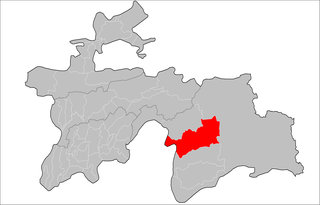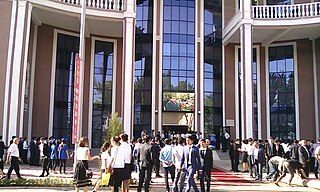Related Research Articles

Tajikistan, officially the Republic of Tajikistan, is a landlocked country in Central Asia. It has an area of 142,326 km2 (54,952 sq mi) and an estimated population of 9,750,065 people. Its capital and largest city is Dushanbe. It is bordered by Afghanistan to the south, Uzbekistan to the west, Kyrgyzstan to the north, and China to the east. It is separated narrowly from Pakistan by Afghanistan's Wakhan Corridor. The traditional homelands of the Tajiks include present-day Tajikistan as well as parts of Afghanistan and Uzbekistan.

The Demographics of Tajikistan is about the demography of the population of Tajikistan, including population growth, population density, ethnicity, education level, health, economic status, religious affiliations, and other aspects of the population.

Tajiks are a Persian-speaking Iranian ethnic group native to Central Asia, living primarily in Afghanistan, Tajikistan, and Uzbekistan. Tajiks are the largest ethnicity in Tajikistan, and the second-largest in Afghanistan and Uzbekistan. They speak varieties of Persian, a Western Iranian language. In Tajikistan, since the 1939 Soviet census, its small Pamiri and Yaghnobi ethnic groups are included as Tajiks. In China, the term is used to refer to its Pamiri ethnic groups, the Tajiks of Xinjiang, who speak the Eastern Iranian Pamiri languages. In Afghanistan, the Pamiris are counted as a separate ethnic group.

Dushanbe is the capital and largest city of Tajikistan. As of January 2022, Dushanbe had a population of 1,201,800 and that population was largely Tajik. Until 1929, the city was known in Russian as Dyushambe, and from 1929 to 1961 as Stalinabad, after Joseph Stalin. Dushanbe is located in the Gissar Valley, bounded by the Gissar Range in the north and east and the Babatag, Aktau, Rangontau and Karatau mountains in the south, and has an elevation of 750–930 m. The city is divided into four districts, all named after Persian historical figures: Ismail Samani, Avicenna, Ferdowsi, and Shah Mansur.

Gorno-Badakhshan, officially the Badakhshan Mountainous Autonomous Region, is an autonomous region in eastern Tajikistan, in the Pamir Mountains. It makes up nearly forty-five percent of the country's land area, but only two percent of its population.

The Tajikistani Civil War, also known as the Tajik Civil War, began in May 1992 when regional groups from the Garm and Gorno-Badakhshan regions of Tajikistan rose up against the newly formed government of President Rahmon Nabiyev, which was dominated by people from the Khujand and Kulob regions. The rebel groups were led by a combination of liberal democratic reformers and Islamists, who would later organize under the banner of the United Tajik Opposition. The government was supported by Russian military and border guards.
The Pamiris are an Eastern Iranian ethnic group, native to the Badakhshan region of Central Asia, which includes the Gorno-Badakhshan Autonomous Region of Tajikistan; the Badakhshan Province of Afghanistan; Taxkorgan Tajik Autonomous County in Xinjiang, China; and the Upper Hunza Valley in Pakistan.

Rushon District is a district in east Tajikistan, in the west-central part of the Gorno-Badakhshan Autonomous Region (GBAO). It stretches along the river Bartang between the Yazgulem Range to the north and the Rushon Range to the south. Its capital is Rushon, also known as Vomar, situated on the border with Afghanistan, 65 km north of Khorugh along the river Panj and the Pamir Highway. The population of Rushon district is 25,800.

Mamadsho Ilolovich Ilolov is President of the Tajik Academy of Sciences, a former member of the Tajikistan Parliament and former Minister of Labor and Social Protection of Population of the Republic of Tajikistan, and former rector of Khorugh State University.

Tajik National University is the first and largest university in Tajikistan with a total of 23,000 students trained per year in 18 different academic branches.

Russian-Tajik Slavonic University (RTSU), also known as Russian-Tajik University, is a university in Tajikistan located in Dushanbe. University was result of cooperation of Russian and Tajik governments. The majority of the students come from Russian families living in Tajikistan and the others are from Tajik and Uzbek families. The university is a member of the Euroasian Universities Association (EUA). Besides being Russian-Tajik the university has students in many nationalities including Armenian, Georgian, Ukrainian and others from Post-Soviet states.

Avicenna Tajik State Medical University or ATSMU is a public university in Tajikistan. Established in 1939, it is located in Dushanbe and named after the Persian polymath Abuali Ibni Sino. It is managed by the Ministry of Health and is the only higher medical education facility in Tajikistan preparing medical personnel for the country.
The Ministry of Health and Social Protection is a government ministry that governs and manages healthcare and the health industry in Tajikistan, including the nation's public health system. The Ministry was founded in 2006 and is located in Dushanbe.

Relations between Afghanistan and Tajikistan began in 1992. Afghanistan maintains an embassy in Dushanbe and a consulate in Khorugh. The current Afghanistan ambassador to Tajikistan is LTG. Mohammad Zahir Aghbar. Tajikistan maintains an embassy in Kabul and a consulate in Mazari Sharif, Faizabad and Kunduz. The current Tajikistan ambassador to Afghanistan is Sharofiddin Imom.

The Ministry of Internal Affairs, also called the Ministry of the Interior, abbreviated VKD, is the interior ministry of the government of Tajikistan. It oversees the Presidential National Guard and the Internal Troops. Since 2012, the Minister of Internal Affairs has been Lieutenant General Ramazon Rahimov. He is responsible for youth crime prevention and working to lower youth crime rates in the country. The law "On Police" was adopted on 7 April 2004 by the Supreme Assembly of Tajikistan to define the duties of the interior ministry.
Alex Sodiqov, born as Alexander Sodiqov is a political science PhD student at the University of Toronto, who was apprehended by security officials in Tajikistan on June 16, 2014 and charged with treason and espionage.
Khudoyor Yusufbekovich Yusufbekov was a Soviet scientist and organizer of scientific projects and institutes in Pamir. He was a leading scientist who made a significant contribution to the development of biological sciences, whose name is connected with a new direction of the development of plant growing in the arid mountain and highland territory of Pamir-Alay; a prominent specialist in the field of plant growing, plant introduction and pasture economy, meadow studies, phyto-amelioration, and botany, Yusufbekov was a practicing field researcher, figure of higher education, and professor. In 1968, he developed a system for fodder improvement in the Pamir and Alay valleys that was differentiated from the perspective of the ecological and geographical areas and high-altitude zones. He also implemented a system of arid fodder, and proposed methods of cultivation of useful plants in the Pamir area in 1972. In 1970—1975, Khudoyor Yusufbekov developed the master plan of reconstruction of the Pamir Botanical Garden. In 1969, he became doctor of the agricultural sciences. In 1976, he became an Academician of the Academy of Sciences of the Tajik Soviet Socialist Republic. In 1962—1969, he was the director of the Pamir Biological Station; at the same time in 1965—1990, he was the Chairman of the Bureau of the Pamir Base; in 1969—1981, the director of the Pamir Biological Institute of the Academy of Sciences of the Tajik SSR; in 1981—1986, the rector of the Tajik Agricultural Institute of the Ministry of Agriculture of the USSR; in 1986—1990, the Academician Secretary of the Biological Department of the Academy of Sciences of the Tajik SSR. From 1989, he was a Member of the Presidium of Academy of Sciences of the Tajik SSR. Moreover, he was a state and public figure, the head of the scientific council of the department of biological science of the Academy of Sciences of the Tajik SSR and a Member of the coordination council of the department of general biology of the Academy of Sciences of the USSR (1987—1990). He was also a fellow of the Geographical Society of the USSR since 1965, Member of the All-Union and Central Asian Councils of the Botanical Gardens of the USSR (1972—1990), Member of the Council on the "Biological Foundations of the Rational Use and Protection of Flora" of the Academy of Sciences of the USSR (1976—1990), Member of the Council on the "Biological Foundations of the Development of Mountain Territories in Central Asia" (1975—1990), Member of the Council of the All-Union Botanical Society (1976—1990).

Zafar Juraevich Usmanov was a Soviet and Tajik mathematician, doctor of physical and mathematical sciences (1974), professor (1983), full member of the Academy of Sciences of the Republic of Tajikistan (1981), Honored scientist of the Republic of Tajikistan (1997), laureate of the State Prize of Tajikistan in the field of science and technology named after Abu Ali ibn Sino (2013).
Yodgor Doyorovich Fayzov is the governor of Tajikistan's southeastern Gorno-Badakhshan Autonomous Region (GBAR). Prior to that he was head of the Aga Khan Foundation office in Tajikistan. Fayzov replaced Shodikhon Jamshed as governor on 1 October 2018, by executive order of Tajik President Emomali Rahmon following civil unrest in the region.
References
- ↑ "Сегодня Лидер нации Эмомали Рахмон произвел кадровые назначения в ряде министерств, ведомств и государственных органов". novosti-tadzhikistana.ru (in Russian). 2022-07-25.
- ↑ "Таджикистан: Электронная газета TRIBUN.TJ". Archived from the original on 2011-10-03. Retrieved 2008-02-18.
- ↑ Golden Melodies: A Musical Journey From Central Asia
1. My journey in Central Asia
2. Tribun - the electronic newsletter of the National Democratic Party